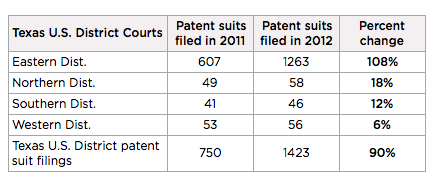© 2013 The Texas Lawbook.
By Mark Curriden, JD
Senior Writer for The Texas Lawbook
The alphabetized listing of new cases filed in the Eastern District of Texas tells the whole story.
Anu IP filed nearly 30 separate lawsuits in 2012 claiming that corporate giants such as Samsung, Toshiba and Panasonic infringed on their patent that covers technology in retractable USB devices.
Blue Spike filed dozens of similar cases for patent infringement of its technology. C4Cast.Com has sued a dozen defendants. Clear With Computers filed two-dozen lawsuits and Dietgoal Innovations another 20. That’s before you get to the E’s.
The number of patent infringement lawsuits filed in Texas federal courts nearly doubled in 2012 and lawyers are predicting it could go even higher in 2013.
The federal courts in the Eastern District of Texas, which includes Marshall, Texarkana and Tyler, saw the number of patent lawsuits jump from 607 in 2011 to 1,263 last year – an increase of 108 percent.
Judges in the Northern District, which includes Dallas and Fort Worth, witnessed an 18 percent increase in new patent cases filed. But legal experts expect that number will significantly increase in 2013 now that three judges in Dallas have committed to focusing more of their time and expertise on intellectual property disputes.
New patent cases increased 12 percent in the Southern District, which includes Houston, and six percent in the Western District, which includes Austin and San Antonio.

Intellectual property experts say that the alphabetized listing of new cases filed is evidence of an ironic twist: The America Invents Act, which was passed by Congressional Republicans and signed by President Obama in 2011, didn’t reduce the amount of new patent lawsuits as promised but actually caused a dramatic increase in new disputes being filed.
“The AIA has impacted the number of patent filings and substantially so,” says Tim Durst, a litigation partner at Baker Botts who specializes in patent disputes. “We’re seeing a large number of separate case filings that previously would have been filed as one case, but are now broken into separate cases with individual defendants.”
A handful of plaintiffs, such as Anu IP, Blue Spike, C4Cast.Com, and Dietgoal Innovations, account for a majority of the patent infringement lawsuits filed in 2012 in Texas, even though none of them or the corporations they are suing have any direct connection to Marshall other than these three simple words found in each of their lawsuits: “does business in.”
William Munck, a partner at Dallas-based Munck Wilson Mandala, says that Congress included a clause legally known as a “joinder provision” in the AIA that prohibited patent holders “from casually suing a plethora of infringement defendants in a single filing” in a single jurisdiction friendly to the plaintiff in hopes of forcing a financial settlement.
“The intent of this provision is to curtail the common wholesale patent troll enforcement strategy of casting a wide net and suing a multitude of unrelated but accused infringers in a single action,” says Munck.
“A patent owner now must file separate suits against each accused infringer and is forced to participate in, contend

with and address both substantive and procedural issues in each action,” he says.
The idea, according to Gil Gillam, a partner at Marshall-based Gillam & Smith, was to increase the costs and legal fees on so-called patent trolls, which supporters hoped would reduce litigation.
“To litigate a case through trial from the standpoint of a plaintiff or a defendant is an expensive proposition,” says Gillam, a Baylor Law School graduate. “Costs and fees go up. They don’t go down.”
Gillam says that plaintiffs have previously been able to “manage costs by having one case against multiple defendants.” Now, those plaintiffs have to fund multiple cases. There has been an impact on defendants, too, he says.
“In the multiple defendant cases, some defendants were content to let defendants with more exposure or a higher profile carry most of the load,” says Gillam. “Thus, [their] costs could be lower. Now companies that truly may have marginal exposure have an individual lawsuit on their hands.”
Lawyers representing patent trolls may have outsmarted Congress in another way.
“What most plaintiffs are doing now is filing multiple lawsuits in the same venue and then asking for consolidation of the cases for pre-trial purposes, which the judge still has discretion to do after AIA,” says Vincent J. Allen, a partner at Carstens & Cahoon in Dallas.

The increase in cases filed means more work for the federal district courts, which consolidate the cases just to handle the workload, says Allen.
Allen and others say that the AIA and the increased caseload in the Eastern District of Texas have helped push some plaintiffs to file their cases in other jurisdictions, including the Northern District of Texas.
IP law experts say they expect the federal courts in Dallas will see a significant increase in its patent dispute caseload during the next few years. They point to a pilot program initiated in 2011 by US District Judge Barbara Lynn, US District Judge David Godbey and US District Judge Ed Kinkeade, which enacted local court rules designed to resolve patent infringement cases faster and cheaper.
In addition, lawyers say that it is unclear what, if any, impact the new Patent and Trademark Office opening in Dallas will have on disputes being filed in Texas.
Even so, Gillam says he doesn’t think there will be a huge decline in the number of new patent cases in the Eastern District because “patent holders continue to view EDTX as a favorable forum” and because judges in Marshall, Tyler and Texarkana have “demonstrated an ability to fairly and efficiently manage these cases.”
“The Eastern District of Texas is still as plaintiff-friendly as it ever was, if venue can be maintained there,” says Allen. “The plaintiff-friendly juries of the Eastern District are still alive and well. This is not to say that plaintiffs win every case—only that, in my view, not much has changed to make the Eastern District less attractive so long as venue can be maintained there under current law.”
© 2013 The Texas Lawbook. Content of The Texas Lawbook is controlled and protected by specific licensing agreements with our subscribers and under federal copyright laws. Any distribution of this content without the consent of The Texas Lawbook is prohibited.
